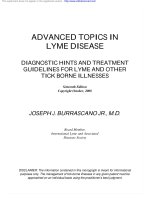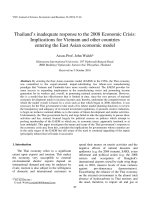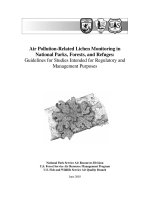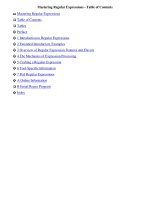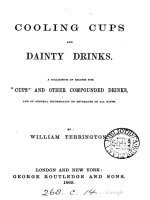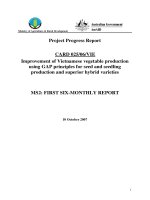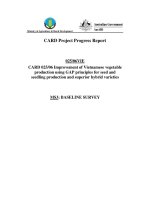PRINCIPLES FOR STUDYING AND MANAGING NATURAL QUIET AND NATURAL DARKNESS IN NATIONAL PARKS AND OTHER PROTECTED AREAS
Bạn đang xem bản rút gọn của tài liệu. Xem và tải ngay bản đầy đủ của tài liệu tại đây (401.79 KB, 13 trang )
Principles for Studying and Managing Natural Quiet
and Natural Darkness in National Parks and Other
Protected Areas
Robert Manning, Peter Newman, Jesse Barber, Christopher Monz,
Jeffrey Hallo, and Steven Lawson
A substantial body of research on natural quiet and natural darkness in national
parks, and protected areas more broadly, has been reported in the scientific and professional
literature in recent years. However, this literature is widely scattered over many academic and
professional journals that cover both the natural and social sciences. To help integrate and
synthesize this body of work, we surveyed this diverse literature and collected representative
examples in a book (Manning et al. 2018). We conclude our book with a series of principles
that we have distilled to help guide park managers to protect natural quiet and natural dark-
ness. This paper presents those principles.
Much of our book focuses on national parks in the United States, and in the remainder
of this paper the phrase “the national parks” refers to them. But we feel that the principles
we have derived from our review of the scientific and professional literature on natural quiet
and natural darkness apply equally well to a variety of parks and protected areas in the United
States and elsewhere.
Natural quiet is generally defined as the sounds of nature uninterrupted by human-caused
noise, and natural darkness is darkness unaffected by human-caused light. It is important to
note that natural quiet and natural darkness do not necessarily mean absolute quiet or dark-
ness, as the natural world often generates sounds of its own (e.g., birds calling, wind blowing,
rivers rushing) and has sources of illumination (e.g., the glow of celestial bodies and the
fluorescence of some plants and animals).
The George Wright Forum, vol. 35, no. 3, pp. 350–362 (2018).
© 2018 George Wright Society. All rights reserved.
(No copyright is claimed for previously published material reprinted herein.)
ISSN 0732-4715. Please direct all permissions requests to
350 • The George Wright Forum • vol. 35 no. 3 (2018)
Principle 1. Natural quiet and natural darkness are the “new” resources of the
national parks.
This assertion is supported in three ways. First, the history of the national parks illustrates a
clear expansion of the resources and values of the national park system. Figure 1 presents an
outline of this evolution, starting with appreciation of grand scenery and moving through a
Figure 1. The evolution of US national park resources.
The George Wright Forum • vol. 35 no. 3 (2018) • 351
host of other valued aspects of national parks: history, cultural heritage, wildlife, education,
ecology and biodiversity, recreation, wilderness, native subsistence, cities and urban areas,
science, and ecosystem services. Natural quiet and natural darkness can be seen as the most
recent additions to this growing list of resources. Second, natural quiet and natural darkness
are increasingly recognized as important resources. The classic definition of a “resource” is
something that has value, but is increasingly scarce. A growing body of scientific and profes-
sional literature illustrates the ways in which natural quiet and natural darkness are vital com-
ponents of our natural environment (e.g., they facilitate natural processes such as predator–
prey relationships and mating behaviors) and contribute to the quality of our lives (e.g., they
enhance our enjoyment and appreciation of national parks and contribute to our health and
well-being). Third, human-caused sound and light have made these resources increasingly
scarce, even in national parks. For example, nearly all national parks include roads and other
transportation corridors that produce a great deal of noise, and this noise is growing louder
with the increase in the numbers of visits to the national parks—now measured in the hun-
dreds of millions annually. More generally, some 63% of US protected areas have undergone
a doubling of background sound levels due to noise, and 21% of these areas have experienced
a tenfold increase (Buxton et al. 2017). Moreover, a landmark study found that almost a fifth
of the earth’s land surface is polluted by light, and light pollution is increasing at a rate of 6%
annually (Cinzano et al. 2001).
Principle 2. The emergence of natural quiet and natural darkness in the scientific,
professional, and public conscience has been accompanied by a revealing set of
concepts and terminology.
Much of the growing literature on natural quiet and natural darkness refers to human-caused
sound and light as noise and light pollution, by-products of our economy and culture that are
unwanted and damaging in the same ways as other, more conventional, forms of pollution.
Excessive noise and light that flow onto another’s property are increasingly referred to as
noise and light trespass and as nuisance noise and light, suggesting that people have a right to
be protected against the detrimental effects of excessive human-caused noise and light. These
terms reflect a growing appreciation of the ecological and experiential values of natural quiet
and natural darkness and increasing concern about the detrimental effects of unwanted and
damaging human-caused noise and light.
Principle 3. Noise pollution can have substantial impacts on the ecological and
biodiversity values of national parks.
A growing number of studies document the multiple and wide-ranging impacts of hu-
man-caused noise on park resources (e.g., Francis et al. 2012; Francis and Barber 2013;
Ware et al. 2015; Simpson et al. 2016; McMahon et al. 2017). A literature review on this top-
ic illustrates several mechanisms by which these impacts occur (Francis and Barber 2013).
For example, chronic and frequent noise interferes with animals’ ability to detect important
sounds, whereas intermittent and unpredictable noise is often perceived as a threat. These
352 • The George Wright Forum • vol. 35 no. 3 (2018)
effects can lead to “fitness costs” to animals, either directly or indirectly—for example, by
compromising predator or prey detection or mating signals, altering the timing of movement
patterns, increasing psychological stress, altering spatial distributions of animals, decreasing
foraging or provisioning efficiency, and altering mate attraction and territorial defense.
Principle 4. Light pollution can have substantial impacts on the ecological and
biodiversity values of national parks.
Many studies detail the impacts of human-caused light on park resources (e.g., Kempen-
aers et al. 2010; Gaston et al. 2013; Lewanzik and Voigt 2014; Altermatt and Ebert 2016;
ffrench-Constant et al. 2016). For example, a literature review (Gaston et al. 2013) docu-
ments the mechanisms by which these impacts occur. The authors note that the biological
world is organized largely by light and darkness: the rotation of the earth partitions time into
a regular cycle of day and night. But the spread of electric lighting causes major perturbations
in these natural light and darkness regimes, affecting life from the cellular to ecosystem lev-
els. The effects can include foundational alteration of natural processes, including primary
productivity; partitioning of temporal niches; repair and recovery of physiological function;
measurement of time through circadian, lunar, and seasonal cycles; detection of resources
and natural enemies; and navigation.
In addition to the impacts on individual species, research suggests that these impacts can
extend from individuals and single species to whole communities of species along with eco-
logical services. For example, reduced flight-to-light behavior of moths may reduce pollina-
tion by and the food source for bats and spiders; altered behavior of birds may lead to both a
mismatch between time of peak demand for food and peak food availability, as well as females’
maladaptive choices of mates; and reduced feeding behavior in bats results in reductions in
pollination and seed dispersal. Research has also addressed the interaction of noise and light
pollution. For instance, both of these forms of pollution affect frog-biting midges and their
túngara frog hosts, disrupting this parasitic relationship (McMahon et al. 2017).
Principle 5. Natural quiet can enhance the quality of the visitor experience in
national parks; correspondingly, noise pollution can substantially diminish it.
Just as the experience of visiting national parks can be improved in the presence of natural
quiet, it can be impaired by human-caused noise (Manning et al. 2010; Park et al. 2010;
Weinzimmer et al. 2014; Benfield et al. 2014; Taff et al. 2014). For example, a survey of
national park visitors found that more than 90% of respondents reported that the enjoyment
of natural quiet and the sounds of nature were primary motivators for their visit (Weinzim-
mer et al. 2014). There is often a strong relationship between the impacts of noise pollution
on the natural environment and on the experience of visiting national parks. For example,
alterations in wildlife distributions and behaviors caused by noise pollution may diminish
visitors’ opportunity to see and hear iconic wildlife. Moreover, natural quiet and lack of noise
pollution can contribute not only to the quality of visiting parks, but also to human health and
well-being (Benfield et al. 2014).
The George Wright Forum • vol. 35 no. 3 (2018) • 353
Principle 6. Likewise, natural darkness can enhance the quality of the visitor
experience in national parks and light pollution diminish it.
As with natural quiet and noise, natural darkness can contribute to the quality of national
park visitors’ experience, while human-caused light can diminish it (Duriscoe 2001; Colli-
son and Poe 2013; Mace and McDaniel 2013; Smith and Hallo 2013; Manning et al. 2015).
For example, Smith and Hallo (2013) call attention to the popularity of nighttime recreation
activities in national parks (e.g., camping, viewing nocturnal wildlife), but light pollution can
damage the quality of these activities. It should be noted that, as is the case with the impacts
of noise pollution described in Principle 5, light pollution’s impacts on the natural environ-
ment can be strongly related to their impacts on the experience of visiting the national parks.
For example, changes in distributions and behaviors of wildlife species caused by light pollu-
tion can affect visitors’ ability to see and hear iconic nocturnal wildlife.
Principle 7. National parks are some of the last refuges of natural quiet and natural
darkness and must be protected.
Many national parks and other protected areas are located far from large metropolitan areas
and therefore have been somewhat insulated from the noise and light generated outside these
parks. Moreover, in a visitor survey conducted at Bryce Canyon National Park, many respon-
dents reported that national parks are the preferred sites to stargaze (Mace and McDaniel
2013). However, natural quiet and natural darkness are threatened in all national parks by
increasing numbers of visits and human-caused noise and light—especially since both noise
and light can travel substantial distances. For example, light can travel up to 200 miles from
its source.
Principle 8. The National Park Service’s recognition of the value of natural quiet and
natural darkness, and its policies and programs to help protect these resources, are
a major advance in the evolution of the agency.
Land-managing agencies need to explicitly value, and manage for, natural quiet and natural
darkness. The National Park Service (NPS) has been a leader in this. Perhaps the most foun-
dational guidance is the Organic Act of 1916 that created NPS, which directed the agency to
manage the national parks to “conserve the scenery and the natural and historic objects and
the wild life [sic] therein.” Of course, there was little thought about natural quiet and natural
darkness at that time, but the act has provided a framework to protect all newly recognized
park resources as scientists, managers, and the public become conscious of them. NPS took
the initiative in 1999 with its creation of the Night Sky Team, designed to monitor light pol-
lution in national parks and advise park staff on how to help prevent and reduce it. In 2000,
NPS established its Natural Sounds and Night Skies Division, whose mission is to “restore,
maintain, and protect acoustical environments and natural dark skies throughout the national
park system.” Furthermore, in 2006 NPS added the protection of natural quiet and natural
darkness to its management policies, the directives that guide the work of the agency. Many
parks participate in this work, developing and presenting interpretive programming to park
visitors, hosting stargazing parties to engage the public in discussions of natural darkness,
354 • The George Wright Forum • vol. 35 no. 3 (2018)
and implementing management actions to protect natural quiet and natural darkness. All this
constitutes a major step forward by the agency toward realizing a full understanding of the
mission set out in the Organic Act.
Principle 9. Protecting natural quiet and natural darkness is an important
manifestation of the twofold mission of the NPS.
National parks are to be managed in ways that provide appropriate public access and enjoy-
ment, but also protect park resources and the quality of visitors’ experiences. But these objec-
tives can often conflict when demand for access to the national parks is high and increasing.
For example, very large numbers of visitors, or even a small number of noisy visitors, can
degrade natural quiet. Visitors can also diminish natural darkness, as can the often extensive
facilities and services in the parks (e.g., roads, hotels, and visitor centers) that are the infra-
structure for visitor use. National parks should be managed to limit the impacts of visitor use
on all important park resources, including natural quiet and natural darkness. An effective
program of reducing visitor-caused noise through educational programming at Muir Woods
National Monument is a good example (Manning et al. 2010).
Principle 10. More research is needed on natural quiet and natural darkness.
The scientific and professional literature on natural quiet and natural darkness is expanding.
However, much more remains unknown than known. Coverage of the impact on species is
spotty at best: we are only beginning to uncover the interrelationships among species, and
the mechanisms by which these interrelationships work; and the important and often cas-
cading ecological effects of noise and light pollution on plant and animal communities are
poorly understood. More research is needed to help guide the formulation of ecological and
experiential indicators and thresholds for both noise and light pollution. Research is needed
to develop effective and efficient monitoring protocols and assess the effectiveness of man-
agement actions. Generally, the literature on noise pollution is more fully developed than that
on light pollution, suggesting the need for a greater emphasis on the latter. Research on noise
and light pollution’s impacts on terrestrial animals and plants is more developed than that
on the impacts on marine environments. Knowledge of the economic impacts of noise and
light pollution (including the benefits of protecting the resources of natural quiet and natural
darkness) is limited. These and many more topics warrant an expanded program of research
to help ensure that the management of these resources is as informed as possible.
Principle 11. Research on natural quiet and natural darkness can and should draw
on a range of scholarly disciplines and incorporate a variety of research methods.
Research on natural quiet and natural darkness comes from both the natural and social sci-
ences, recognizing the multi- and interdisciplinary character of these resources. Where ap-
propriate, work in the natural and social sciences should be integrated. For example, the
natural sciences can help identify the ecological impacts of human-caused noise and light,
while the social sciences can help determine societal norms for the maximum acceptable
levels of this pollution. Research also employs a range of study methods, including both lab-
The George Wright Forum • vol. 35 no. 3 (2018) • 355
oratory and field experiments. Scientists should think broadly about the range of disciplines
and methods that can be brought to bear on understanding and managing natural quiet and
natural darkness.
Principle 12. Many of the impacts of human-caused noise and light are reversible,
though it is becoming evident that some may not be.
Excessive noise and light can be reduced or even eliminated (sometimes with little cost or
effort), and thus their impacts can be substantially diminished. For example, many traditional
forms of transportation now employ new, quieter technology. Moreover, an increasing num-
ber of national parks are using forms of public transit such as shuttle buses to reduce the
number of cars and associated noise (Manning et al. 2014). Similarly, new lighting technolo-
gies, including lights that are oriented more directly down at their target—which allows less
light to escape into the atmosphere—can reduce the amount of light needed in national parks.
The use of lights that are activated by motion sensors, so they come on only when needed,
is another way to reduce light pollution. These technologies and best management practices
can substantially reduce human-caused noise and light in the national parks and elsewhere,
suggesting that natural quiet and natural darkness can be considered renewable resources.
However, some impacts of human-caused noise and light may not be reversible. For example,
the decreased moth flight-to-light behavior that has been found in some research may be the
product of a microevolutionary response to contemporary light environments and thus likely
difficult to reverse (Altermatt and Ebert 2016).
Principle 13. Human-caused sound and light can be important cultural resources in
certain contexts.
In the context of some national parks and related areas, selected forms of human-caused
sound and light can be considered valuable cultural resources. For example, at San Antonio
Missions National Historical Park, the sounds of church bells add an authentic layer of sound
to the park experience. And in national park sites related to the Civil War, such as Gettysburg
National Military Park, booming cannons can add to the authenticity of the visitor experi-
ence. Similarly, light is not inherently deleterious in national parks, at least from an experi-
ential perspective: well-designed and appropriate lighting allows some park resources to be
viewed so as to be better appreciated. An obvious example is the caves of Carlsbad Caverns
National Park (though these lights and visitors’ use of the area has reduced the presence of
bats). And well-designed lights can add drama and aesthetic appeal to cultural sites, such
those that illuminate the American flag flying over Fort McHenry National Monument and
Historic Shrine and the monuments and memorials of the National Mall and Memorial Parks
in Washington, DC.
Principle 14. Natural quiet and natural darkness are common property resources
that should be managed to protect the quality of park resources and visitors’
experiences.
Natural quiet and natural darkness are examples of common property resources—resources
356 • The George Wright Forum • vol. 35 no. 3 (2018)
that are owned by all, but that are inherently vulnerable to use-related impacts caused by in-
dividuals. Common property resources are subject to overuse and degradation if they are not
managed appropriately. In his classic paper “The Tragedy of the Commons,” Garrett Hardin
suggested that “mutual coercion, mutually agreed upon” is needed to manage common prop-
erty resources (Hardin 1968: 1247). In other words, society must agree on, and then abide
by, rules that govern the amount and types of uses of common property resources in order
to protect them. Government agencies responsible for managing common property resourc-
es—NPS, in the case of America’s national parks—must establish and enforce such rules. Of
course, these rules must be developed in consultation with the public.
Principle 15. The closely related conceptual frameworks of carrying capacity, limits
of acceptable change, and indicators and thresholds should be used to help protect
important park resources, including natural quiet and natural darkness.
Carrying capacity is defined as the amount and type of visitor use that can be accommodated
in a park or related area without having unacceptable impacts on park resources and the
quality of visitors’ experiences. The concept of limits of acceptable change recognizes that
visitors’ use of national parks will inevitably have some impacts, but these impacts must be
limited to maintain the quality of park resources and experiences. Indicators and thresholds
empirically define the limits of acceptable change. These three conceptual frameworks can
be integrated and made operational in the form of an adaptive, management-by-objectives
process such as Visitor Use Management (Interagency Visitor Use Management Council
2016). First, management objectives are formulated that describe the desired conditions of
park resources and experiences. These objectives are then expressed in empirical terms in
the form of indicators and thresholds. Indicators are measurable, manageable variables that
serve as quantitative proxies for management objectives, and thresholds define the minimum
acceptable condition of indicator variables. Second, indicators are periodically monitored to
assess their condition. Third, management actions (as outlined in principle 16) are applied
to help ensure that the condition of indicator variables does not fall below defined thresh-
olds. Application of this management-by-objectives framework is an ongoing and adaptive
process: it provides periodic information on the condition of indicator variables as well as
the effectiveness of management actions, and managers can adjust those actions as warranted
and guided by monitoring data.
Principle 16. A range of management strategies and practices can be used to protect
natural quiet and natural darkness in the national parks, but new approaches will
also be required.
The literature is suggestive of the ways in which NPS can help protect natural quiet and
natural darkness. For example, a “quiet zone” and “quiet days” were designated at Muir
Woods National Monument, and an educational program was implemented to communicate
to visitors the importance of protecting natural quiet (Manning et al. 2010). This program
was found to be effective, substantially reducing the level of visitor-caused noise, and was
well received by visitors. In another study, educational messages about military flights over
The George Wright Forum • vol. 35 no. 3 (2018) • 357
Sequoia National Park were found to be effective in reducing the impacts of these flights on
the visitor experience (Taff et al. 2014). However, these are only very limited examples. The
professional literature suggests that there are four basic strategies for reducing recreation-re-
lated impacts in parks and related reserves: limit use, increase the supply of opportunities, re-
duce the impacts of use (through changes in visitor behavior), and harden park resources and
experiences (that is, make them more resistant to potential impacts; Manning et al. 2017).
In addition, six basic practices can be used to carry out these strategies: information/educa-
tion, zoning, rules and regulations, law enforcement, rationing/allocation, and site design and
maintenance. Relatively little is known about the effectiveness of these management strategies
and practices in protecting natural quiet and natural darkness and related visitor experiences,
and this topic deserves more study.
Principle 17. A landscape-scale approach is needed to protecting natural quiet and
natural darkness in the national parks.
It is becoming increasingly apparent that many conservation issues require a landscape-scale
approach to their solution, because some of the impacts on parks are caused by sources out-
side their boundaries. This is especially the case with natural quiet and natural darkness.
Human-generated noise that is produced outside the parks may drift into them, disturbing
natural quiet. Transportation-related noise is a good example. Human-caused light generated
outside parks can also intrude, disturbing natural darkness. Most national parks and other
protected areas are not large enough to be fully insulated from these types of external threats.
Progressive national park management must include reaching out to neighboring landown-
ers—other public land management agencies, surrounding communities, nonprofit organi-
zations, and private landowners—working with them to limit impacts on natural quiet and
natural darkness. This type of outreach has succeeded at Acadia National Park and Chaco
Culture National Historical Park. NPS staff members at Acadia collaborated with officials in
Bar Harbor, Maine, the gateway town to the park, and this resulted in passage of a progres-
sive ordinance that reduces the amount of light that drifts into the park. And park managers
at Chaco Culture worked with a group of stakeholders in New Mexico to convince the state
legislature to pass an act that limits light pollution throughout the state. An innovative and
promising landscape-scale initiative called the Dark Sky Preserve is now under way on the
Colorado Plateau, a large geographic region in the American Southwest. This is an NPS-led
effort to coordinate management of the many national parks in this region to help preserve
the remarkable quality of their natural darkness. This landscape-scale approach to managing
natural darkness is strongly supported by park visitors: for example, a survey of visitors to
Bryce Canyon National Park found that nearly 90% of respondents believe “that areas near
national parks should assist in maintaining dark night skies” (Mace and McDaniel 2013).
Principle 18. A large network of partners and stakeholders will be required to
protect natural quiet and natural darkness in the national parks.
Many partners are needed to work with NPS to advance the protection of natural quiet and
358 • The George Wright Forum • vol. 35 no. 3 (2018)
natural darkness, for two basic reasons. First, as noted in principle 17, many threats to these
resources emanate from outside the parks. Second, NPS has limited funding and staffing to
do all the work that is needed. In the case of Chaco Culture National Historical Park, many
stakeholder groups participated in successfully lobbying the New Mexico state legislature
to pass the statewide outdoor lighting ordinance. Local astronomers and related organiza-
tions, along with a host of volunteers, are instrumental in hosting stargazing parties at many
national parks, offering programming related to the night sky and setting up their telescopes
for park visitors. In Sequoia National Park, managers are collaborating with the local military
base to help minimize the impacts of aircraft overflights on the park’s natural quiet (Taff et
al. 2014). The International Dark Sky Association is instrumental in advancing the cause
of night sky protection, certifying parks and local communities that meet best management
practices. Local communities are interested in advancing tourism-based economic develop-
ment through protecting high-quality natural quiet and natural darkness in the parks near
them. Natural and social scientists are advancing our knowledge of natural quiet and natural
darkness, which can inform effective park management. Perhaps the strongest advocates of
natural quiet and natural darkness are park visitors, many of whom visit the parks, at least in
part, to experience those resources (Mace and McDaniel 2013; Smith and Hallo 2013).
Principle 19. Natural quiet and natural darkness should be incorporated into
comprehensive park management plans.
As is clear from several of the preceding principles, natural quiet and natural darkness are
important natural, cultural, and recreational resources in the national parks. NPS has a plan-
ning process in which foundation statements are periodically prepared for all units of the
national park system, followed by a portfolio of specific plans based on the operational and
management needs of each park. Natural quiet and natural darkness should receive explicit
consideration in this planning process. What resources related to natural quiet and natural
darkness are found in each park? What are the challenges and threats to protecting these re-
sources? Do these resources need to be restored? Many parks include specific plans that ad-
dress resources or operations that are especially important to them; examples include natural
and cultural resources, wilderness, transportation, and visitor use management. At parks with
iconic natural quiet and natural darkness, plans focused on these resources may be justified.
Alternatively, natural quiet and natural darkness should be explicitly considered within the
foundation statements and more specific types of plans noted above.
Principle 20. More information and educational programs are needed on natural
quiet and natural darkness.
NPS has a long history of providing high-quality education to visitors about the natural,
cultural, and recreational resources of the national parks. In NPS lingo, this is called “inter-
pretive programming” because it “interprets” technical information about the parks in ways
that are engaging and aimed at a nontechnical audience. Classic examples are nature walks
and campfire talks, though the form of these programs has been substantially updated to
The George Wright Forum • vol. 35 no. 3 (2018) • 359
include collaborative relationships with local schools and a strong presence on the Internet
and through social media (Manning et al. 2016). More programming is needed on the newly
recognized resources of natural quiet and natural darkness.
Principle 21. Management of natural quiet and natural darkness should be conduct-
ed in a proactive manner.
Like all good park management, potential problems should be addressed before they reach
crisis proportions. Unfortunately, human-caused noise and light have already diminished
park resources and the quality of the visitor experience. While a growing body of research
has advanced our understanding of natural quiet and natural darkness, much remains to be
learned (principles 10 and 11). But this should not be an impediment to an aggressive pro-
gram of management. We will never have complete knowledge of the ecological and experi-
ential impacts on natural quiet and natural darkness, the causes and consequences of these
impacts, and the effectiveness of alternative management practices. After making a good-
faith effort to inform themselves, park managers must ultimately exercise their professional
judgment in protecting natural quiet and natural darkness. Managers should find courage in
their knowledge of the burgeoning scientific and professional literature, the conceptual and
management frameworks that have emerged from this literature, and the trust the public has
placed in them to protect park resources and experiences. Recognition and protection of
natural quiet and natural darkness will require strong and deliberate management action and
a promise to manage by design, not by default.
References
Altermatt, Florian, and Dieter Ebert. 2016. Reduced flight-to-light behavior of moth pop-
ulations exposed to long-term urban light pollution. Biology Letters 12(4): 20160111.
Benfield, Jacob, Derrick Taff, Peter Newman, and Joshua Smyth. 2014. Natural sound facili-
tates mood recovery from stress. Ecopsychology 6(3): 183–188.
Buxton, Rachel T., Megan F. McKenna, Daniel Mennitt, Kurt Fristrup, Kevin Crooks, Lisa
Angeloni, and George Wittmeyer. 2017. Noise pollution is pervasive in U.S. protected
areas. Science 356(6337): 531–533.
Cinzano, P., F. Falchi, and C.D. Elvidge. 2001. The first world atlas of the artificial night sky
brightness. Monthly Notices of the Royal Astronomical Society 328(3): 689–707.
Collison, Frederick, and Kevin Poe. 2013. Astronomical tourism: The astronomy and dark
sky program at Bryce Canyon National Park. Tourism Management Perspectives 7: 1–15.
Duriscoe, Dan. 2001. Preserving pristine night skies in national parks and the wilderness
ethic. The George Wright Forum 18(4): 54–59.
ffrench-Constant, Richard, Robin Somers-Yeates, Jonathan Bennie, Theodoros Economou,
David Hodgson, Adrian Spalding, and Peter McGregor. 2016. Light pollution is asso-
ciated with earlier tree budburst across the United Kingdom. Proceedings of the Royal
Society B: Biological Sciences 283: 20160813.
Francis, Clinton, Nathan Kleist, Catherine Ortega, and Alexander Cruz. 2012. Noise pollu-
360 • The George Wright Forum • vol. 35 no. 3 (2018)
tion alters ecological services: Enhanced pollination and disrupted seed dispersal. Pro-
ceedings of the Royal Society B: Biological Sciences 279(1739): 2727–2735.
Francis, Clinton and Jesse Barber. 2013. A framework for understanding noise impacts on
wildlife: An urgent conservation priority. Frontiers in Ecology and the Environment
11(6): 305–313.
Hardin, G. 1968. The tragedy of the commons. Science 162: 1243–1248.
Interagency Visitor Use Management Council. 2016. Visitor Use Management Framework:
A Guide to Providing Sustainable Outdoor Recreation. Online at https://visitoruseman-
agement.nps.gov/.
Gaston, Kevin, Jonathan Bennie, Thomas Davies, and John Hopkins. 2013. The ecological
impacts of nighttime light pollution: A mechanistic appraisal. Biological Reviews 88(4):
912–927.
Kempenaers, Bart, Pernilla Borgstroem, Peter Loes, Emmi Schlicht, and Mihai Valcu. 2010.
Artificial night lighting affects dawn song, extra-pair siring success, and lay date in song-
birds. Current Biology 20(19): 1735–1739.
Lewanzik, Daniel, and Christian Voight. 2014. Artificial light puts ecosystem services of fru-
givorous bats at risk. Journal of Applied Ecology 51(2): 388–394.
Mace, Britton, and Jocelyn McDaniel. 2013. Visitor evaluation of night sky interpretation in
Bryce Canyon National Park and Cedar Breaks National Monument. Journal of Inter-
pretation Research 18(1): 39–57.
Manning, Robert, Peter Newman, Kurt Fristrup, Dave Stack, and Ericka Pilcher. 2010. A
program of research to support management of visitor-caused noise at Muir Woods Na-
tional Monument. Park Science 26(3): 54–58.
Manning, Robert, Steven Lawson, Peter Newman, Jeffrey Hallo, and Christopher Monz.
2014. Sustainable Transportation in the National Parks: From Acadia to Zion. Hanover,
NH: University Press of New England.
Manning, Robert, Rolf Diamant, Nora Mitchell, and David Harmon, eds. 2016. A Thinking
Person’s Guide to America’s National Parks. New York: George Braziller.
Manning, Robert, Laura Anderson, and Peter Pettengill. 2017. Managing Outdoor Recre-
ation: Case Studies in the National Parks. 2nd ed. Wallingford, UK: CABI.
Manning, Robert, Ellen Rovelstad, Chadwick Moore, Jeffrey Hallo, and Brandi Smith. 2015.
Indicators and standards of quality of viewing the night sky in the national parks. Park
Science 32(2): 1–9.
Manning, Robert, Peter Newman, Jesse Barber, Christopher Monz, Jeffery Hallo, and Steven
Lawson. 2018. Natural Quiet and Natural Darkness: The “New” Resources of the Na-
tional Parks. Hanover, NH: University Press of New England.
McMahon, Taegan, Jason Rohr, and Ximena Bernal. 2007. Light and noise pollution interact
to disrupt interspecific interactions. Ecology 98(5): 1290–1299.
Park, Logan, Steven Lawson, Ken Kaliski, Peter Newman, and Adam Gibson. 2010. Model-
ing and mapping hikers’ exposure to transportation noise in Rocky Mountain National
Park. Park Science 26(3): 59–64.
The George Wright Forum • vol. 35 no. 3 (2018) • 361
Simpson, Steven, Andrew Radford, Sophie Nedelec, Maud Ferrari, Douglas Chivers, Mark
McCormick, and Mark Meekan. 2016. Anthropogenic noise increases fish mortality by
predation. Nature Communications 7: 1–7.
Smith, Brandi and Jeffrey Hallo. 2013. A system-wide assessment of night resources and
night recreation in the U.S. National Parks: A case for expanded definitions. Park Sci-
ence 29(2): 54–59.
Taff, Derrick, Peter Newman, Steven Lawson, Alan Bright, Lelaina Marin, Adam Gibson, and
Tim Archer. 2014. The Role of Messaging on Acceptability of Military Aircraft Sounds
in Sequoia National Park. Applied Acoustics 84: 122–128.
Ware, Heidi, Christopher McClure, Jay Carlisle, and Jesse Barber. 2015. A phantom road
experiment reveals traffic noise is an invisible source of habitat degradation. Proceedings
of the National Academy of Sciences 112(39): 12105–12109.
Weinzimmer, David, Peter Newman, Derrick Taff, Jacob Benfield, Emma Lynch, and Paul
Bell. 2014. Human responses to simulated motorized noise in national parks. Leisure
Sciences 36(3): 251–267.
Robert Manning, University of Vermont (emeritus), 1829 Starview, Prescott, AZ 86305;
Peter Newman, Penn State University, 801G Donald H. Ford Bldg., University Park, PA
16802;
Jesse Barber, Boise State University, Science Bldg., Rm. 114, Boise, ID 83725; jessebar-
Christopher Monz, Utah State University, Logan, UT 84321;
Jeffery Hallo, Clemson University, 280B Lehotsky Hall, Clemson, SC 29634; jhallo@clem-
son.edu
Steven Lawson, RSG, Inc., 55 Railroad Row, White River Junction, VT 05001; steve.law-
362 • The George Wright Forum • vol. 35 no. 3 (2018)

